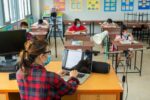Schools are officially in the age of technological learning. There are 1:1 programs, hybrid classrooms, free online learning platforms, eLearning applications and assessments, video collaborations, and the expectation of more to come with developments in augmented and virtual reality technologies.
While useful, these technologies can come with challenges. This includes:
More News from eSchool News
Understanding why students cheat and use AI: Insights for meaningful assessments
In recent years, the rise of AI technologies and the increasing pressures placed on students have made academic dishonesty a growing concern. Students, especially in the middle and high school years, have more opportunities than ever to cheat using AI tools.
6 ways tech simplifies school communication and engagement
As technology trainers, we support teachers’ and administrators’ technology platform needs, training, and support in our district. We do in-class demos and share as much as we can with them, and we also send out a weekly newsletter.
With AI coaching, a math platform helps students tackle tough concepts
Math is a fundamental part of K-12 education, but students often face significant challenges in mastering increasingly challenging math concepts.
Opportunities in failing: Why K-12 education needs more productive struggle
Throughout my education, I have always been frustrated by busy work–the kind of homework that felt like an obligatory exercise rather than a meaningful learning experience.
How will schools replace devices bought during the pandemic?
During the pandemic, thousands of school systems used emergency relief aid to buy laptops, Chromebooks, and other digital devices for students to use in remote learning.
How multimedia and interactive tech transform engagement
Education today looks dramatically different from classrooms of just a decade ago. Interactive technologies and multimedia tools now replace traditional textbooks and lectures, creating more dynamic and engaging learning environments.
Using technology to support learning through movement
There is significant evidence of the connection between physical movement and learning. Some colleges and universities encourage using standing or treadmill desks while studying, as well as taking breaks to exercise.
Halting education research in the name of ‘government efficiency’ is incredibly inefficient
This story was originally published by Chalkbeat. Sign up for their newsletters at ckbe.at/newsletters. In recent weeks, we’ve seen federal and state governments issue stop-work orders, withdraw contracts, and terminate…
Report details uneven AI use among teachers, principals
English/language arts and science teachers were almost twice as likely to say they use AI tools compared to math teachers or elementary teachers of all subjects, according to a February 2025 survey from the RAND Corporation.
COVID still casts a shadow over American school boards
During the seven years I served on the Derry School Board in New Hampshire, the board often came first. During those last two years during COVID, when I was chair, that meant choosing many late-night meetings over dinner with my family.











